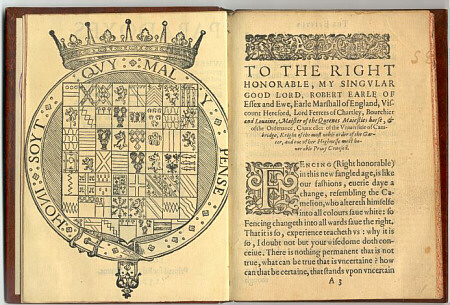
email:
for more information on obtaining "En Garde! A Selection from the Corble Collection" CD.
George Silver, "Paradoxes of Defence...", 1599
Note: Access to the George Silver resources is available to students and members of the Academy of European Medieval Martial Arts (AEMMA), along with complete access to Fiore dei Liberi and Capo Ferro resources. This is particularly important for those students who are recruits training at AEMMA. It is thought that access to Silver and Liberi provides all of the basis for recruit level of training, and to Capo Ferro for the Rapier training. Those individuals who have achieved scholler rank, can request access to the entire online library resource by contacting the AEMMA executive.
George Silver was a martial arts instructor and Gentleman (of a peerage class, but not necessarily a noble) in England during the late 16th and early 17th century. Extremely nationalistic he objected to what he characterized as a pernicious influence of the fashionable continental rapier systems being taught at the time on a number of ethical and technical levels, referring in particular to the Italian rapier fencing style.
 |
| Courtesy of Leuven University Press, email: for more information on obtaining "En Garde! A Selection from the Corble Collection" CD. |
The complete title (using the original spelling - "/" indicates line breaks in the original title) as "PARADOXES OF DEFENCE, / WHEREIN IS PROVED THE TRUE / grounds of Fight to be the short auncient weapons, / and that the short Sword hath advantage over the long / Sword or long Rapier. And the weakenness and imper- / fection of the Rapier-fights displayed. Together with an / Admonition to the noble, ancient, victorious, valiant, / and most brave nation of Englishmen, to beware of false / teachers of Defence, and how they forsake their owne / natural fights : with a briefe commendation of / the noble science or exercising of / Armes."
Notice: Click here for details on registering with AEMMA and obtaining your Online Library electronic card for access to the other resources in this online library.
 |  |  |
| A few additional images from the Corble CD. Click on either one to view a larger image of the same. | ||